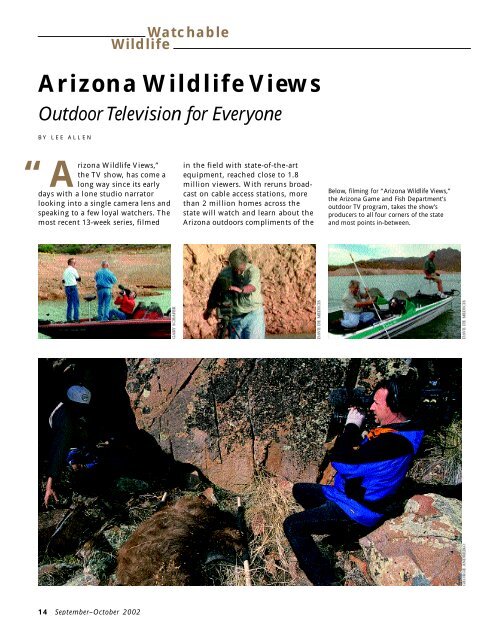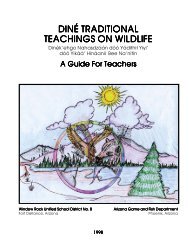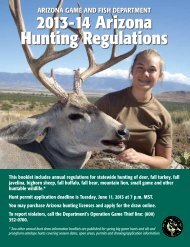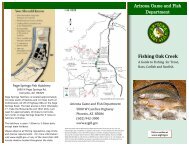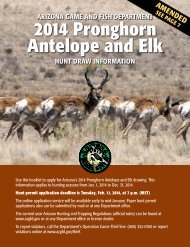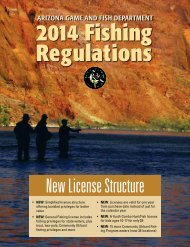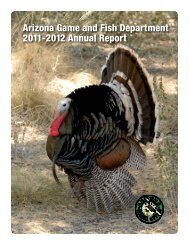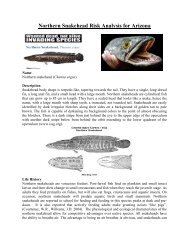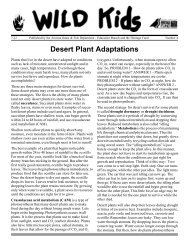Views TV - Arizona Game and Fish Department
Views TV - Arizona Game and Fish Department
Views TV - Arizona Game and Fish Department
Create successful ePaper yourself
Turn your PDF publications into a flip-book with our unique Google optimized e-Paper software.
WatchableWildlife<strong>Arizona</strong> Wildlife <strong>Views</strong>Outdoor Television for EveryoneB Y L E E A L L E N“<strong>Arizona</strong> Wildlife <strong>Views</strong>,”the <strong>TV</strong> show, has come along way since its earlydays with a lone studio narratorlooking into a single camera lens <strong>and</strong>speaking to a few loyal watchers. Themost recent 13-week series, filmedin the field with state-of-the-artequipment, reached close to 1.8million viewers. With reruns broadcaston cable access stations, morethan 2 million homes across thestate will watch <strong>and</strong> learn about the<strong>Arizona</strong> outdoors compliments of theBelow, filming for “<strong>Arizona</strong> Wildlife <strong>Views</strong>,”the <strong>Arizona</strong> <strong>Game</strong> <strong>and</strong> <strong>Fish</strong> <strong>Department</strong>’soutdoor <strong>TV</strong> program, takes the show’sproducers to all four corners of the state<strong>and</strong> most points in-between.14 September–October 2002
<strong>Arizona</strong> <strong>Game</strong> <strong>and</strong> <strong>Fish</strong> <strong>Department</strong>.“We’re the No. 1 game in town,the best bang for the buck for <strong>Arizona</strong>hunters <strong>and</strong> fishing enthusiaststo find out what’s going on in ouroutdoors,” says the show’s currentvideographer <strong>and</strong> longtime <strong>Game</strong><strong>and</strong> <strong>Fish</strong> employee, Gary Schafer.It was not always thus, especiallyat the start. Early iterations beganappearing on a single Phoenix televisionstation in the late 1960s withhost Bill Sizer joined by several coanchorsincluding former <strong>Game</strong><strong>and</strong> <strong>Fish</strong> Information Officer BobHirsch. “The show, originally just15 minutes in length, was Hirsch’sidea, <strong>and</strong> it was a jewel,” says Sizer.“We had no technical tricks likefades or dissolves or anything likethat, but despite our lack of sophistication,people liked it. There wereno reruns, so we shot raw film constantly,right up to show time—<strong>and</strong>things got pretty frantic. Despite thefact we were up against “Ironsides”<strong>and</strong> “Flip Wilson,” we still got ourshare of the audience.”Sizer <strong>and</strong> Hirsch, both knowledgeableon a variety of outdoorsubjects, could often be seen perusingreference books right beforeshow time to learn more aboutmountain lions or s<strong>and</strong>hill cranes.“We were a bunch of talking headswho invited wildlife managers totell about their units, what game<strong>and</strong> fish were there, <strong>and</strong> the problemsthey encountered,” remembersRight, shooting an early “Wildlife <strong>Views</strong>”firearms safety film, “This Little Bullet,”with John Wayne. Above, the first “Wildlife<strong>Views</strong>” host, Bill Sizer (right), during theshow’s “talking heads” days.Wildlife <strong>Views</strong> 15
WatchableWildlifeHirsch. “The <strong>Department</strong>’s missionwas a lot simpler than the complicatedorganization it is today. Thesewere great times, <strong>and</strong> we were giventhe freedom to be creative. Despiteour limited resources we producedsome good stuff, <strong>and</strong> although theshow was taped, we never redid asegment, so it might as well havebeen live television.”Shortly after its inception, Wes Keyesjoined the agency <strong>and</strong> the show, <strong>and</strong>until his retirement in July 2002,appeared as program host for threedecades. “I’d be lying if I told you Iwon’t miss it,” says Keyes. “But it’stime for somebody else to step up <strong>and</strong>take the program to the next level.”There were some on-again/off-againtimes for this distinctly original <strong>TV</strong>fare. Just out of its infancy, the fledglingshow was put on the shelf whena severe drought in the early 1970sput the agency in a budget crunch.The <strong>Department</strong> instead filmed specialoutdoor programming that airedon several stations in the Valley <strong>and</strong>produced a series of films on wildlife<strong>and</strong> fishing subjects—including oneof its early prizes, a firearms safetyfilm called “This Little Bullet.” John“Duke” Wayne was part of the cast.Half-hour shows under the guiseof “<strong>Arizona</strong> Outdoors” began showingup again in thelate 1980s, with NedSmith, another earlyAWV host. Thoseshows went off theair after a two-yearrun. By the fall of1991, “<strong>Arizona</strong> Wildlife<strong>Views</strong>” was onceagain airing as anannual 13-programseries. In late 1994,discussions beganwith PBS affiliates inTucson (KUAT) <strong>and</strong>Phoenix (KAET) tobegin broadcasting theseries in the spring of1995. They’ve neverlooked back—unless itwas to pick up one ofseveral awards.“This show doesgreat things for the <strong>Game</strong> <strong>and</strong> <strong>Fish</strong><strong>Department</strong>,” says Keyes. “Viewersurveys tell us that the program keepsthe <strong>Department</strong> in the minds of thosewho enjoy outdoor activities. We airon 16 local cable access channels, <strong>and</strong>they run the programs forever, sixtimes a day.”The now-retired video productionsupervisor says his 31 years flew by <strong>and</strong>gave him more action <strong>and</strong> memoriesthan scrapbooks will hold. “I’ve beento all four corners of the state <strong>and</strong> mostof the outdoor nook-<strong>and</strong>-crannies inbetween,<strong>and</strong> it’s been awesome.”Programming in the early days involvedsuch things as filming the firstRocky Mountain bighorn sheep releasein the Blue River drainage; nettingApache trout from Soldier River; usinga long lens to shoot rattlesnakes coiledin paloverde trees when Painted RockReservoir filled with floodwaters; <strong>and</strong> reintroducingantelope in Clayhole Washon the <strong>Arizona</strong> Strip.His last official film assignmentwas covering therecent Rodeo-Chediski firein the White Mountains.“Utterly unbelievable,” hesays of the 469,000-acrefire, a dramatic ending forhis career.Keyes, 17-year veteranAbove, videographer/producerGary Schafer, a 17-year veteranof the show. Left, new-kid-onthe-blockDave de Medicis.Right, Wes Keyes on his lastofficial assignment coveringthe recent Rodeo-Chediski firein the White Mountains.16 September–October 2002
Schafer, <strong>and</strong> the new-kid-on-theblock,producer Dave de Medicis, allhave their share of memories. Schaferstill chuckles about his first day onthe job, when he was fresh out ofschool <strong>and</strong> lacking in field experience.The call came abruptly to do a shootin the wild—now. He scrambled, madeit to the remote site, set up his gear—<strong>and</strong> only then remembered that histape stock was back at the office. Eachday on the job is different, he says.“In the middle of June one year, I wason a Flagstaff mountaintop filmingendangered plants on Agassiz Peak<strong>and</strong> having to defrost my lens. Thenext day I was in s<strong>and</strong> dunes in Yumaburning my legs through denim jeansit was so dang hot. Freezing cold oneday, burning hot the next, all in a 24-hour period to get the job done.”Keyes figured the hot-cold, updownvariations were supposed to bepart of the task in bringing story <strong>and</strong>picture to his audiences. “From 120degrees in the Mohawk Dunes to 10degrees in a turkey blind at Chevelon,from fighting gale-force winds in a64-foot houseboat on Lake Powell tofreezing cameras in high-country elkscouts, from treeing a mountain lionon mule back to collaring bears onFour Peaks—I’ve come darn close todoing it all <strong>and</strong> sharing it with ourviewers.” His favorite trip? After along pause, his response is what it hasalways been: “I can’t answer that.There’ve been too many good trips totry <strong>and</strong> single out just one.”The outdoors <strong>and</strong> the audiovisualworld have captivated new producerde Medicis for years—“National Geographic”<strong>and</strong> “Wild Kingdom” werepart of his youth. Today he not onlyproduces “<strong>Arizona</strong> Wildlife <strong>Views</strong>,” he<strong>and</strong> his dog Smoky watch other outdoorshows together. Their <strong>TV</strong> trainingtime has helped the crew earn a trophycase full of awards, like Emmysfrom the National Academy of TelevisionArts <strong>and</strong> Sciences <strong>and</strong> accoladesfrom the National Press PhotographersAssociation. “I’m a storyteller<strong>and</strong> this show, from initial shoot tofinal edit, allows me to do in-depthstory telling.”While trying to be all things to allpeople is often a setup for failure, theshow subjects currently available on“<strong>Arizona</strong> Wildlife <strong>Views</strong>” come close toaccomplishing that mission. Upcomingshows include a look at big-gameanimals, rattlesnake relocation, shootingsports, boating safety, trout fisheries,<strong>and</strong> three-wheeling. The change fromearly-day single-focus feature-orientedpresentations to the current magazineformat was a tough decision. “Producinga magazine-format show, coveringtwo or three topics in a single program,<strong>and</strong> having to shoot some three dozensegments a year is labor intensive,especially for a threepersoncrew,” saysKeyes. “It’s a bigmountain to climb,but the results havebeen very favorable.Viewers enjoy themix of subjects. Ifthere is somethingthey aren’t particularlyinterested in,they’ll stay tuned forthe next segment.”Pride of ownershipis evident intalking with anyoneconnected with theshow. “We have afoot in severalworlds,” says Schafer.“We’re part of theentertainment industryas well as beingeducators in therecreation field. Wecompete with everyother outdoor showon <strong>TV</strong>, from JimmyHouston to ESPN<strong>and</strong> the Outdoor LifeChannel, for ourviewing audience.We’ve found ourniche as the outdoorvoice for the State of<strong>Arizona</strong>, <strong>and</strong> whatwe do, we do well.”“The <strong>Department</strong>has reason to beproud of AWV,” saysKeyes with pride. “This series is notthe norm of cable programming, <strong>and</strong>it’s not the fin <strong>and</strong> fur of most outdoorshows. We like to feel we’re theforerunner in homegrown naturalresourceprogramming.”To locate a participating <strong>TV</strong> stationin your area, or for show dates<strong>and</strong> times, log on to the <strong>Department</strong>Web site at www.azgfd.com.Outdoor writer Lee Allen spends as muchtime as he can doing in-the-field research.When he can’t be playing in the outdoors,he enjoys nature by proxy whilewatching “<strong>Arizona</strong> Wildlife <strong>Views</strong>.”Wildlife <strong>Views</strong> 17


